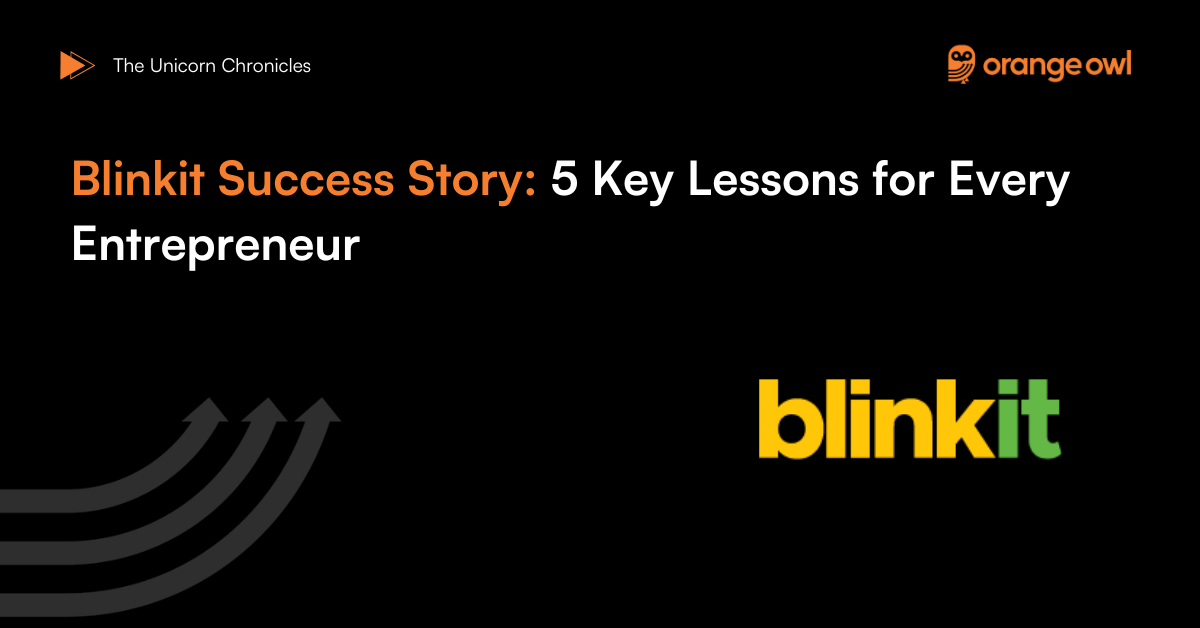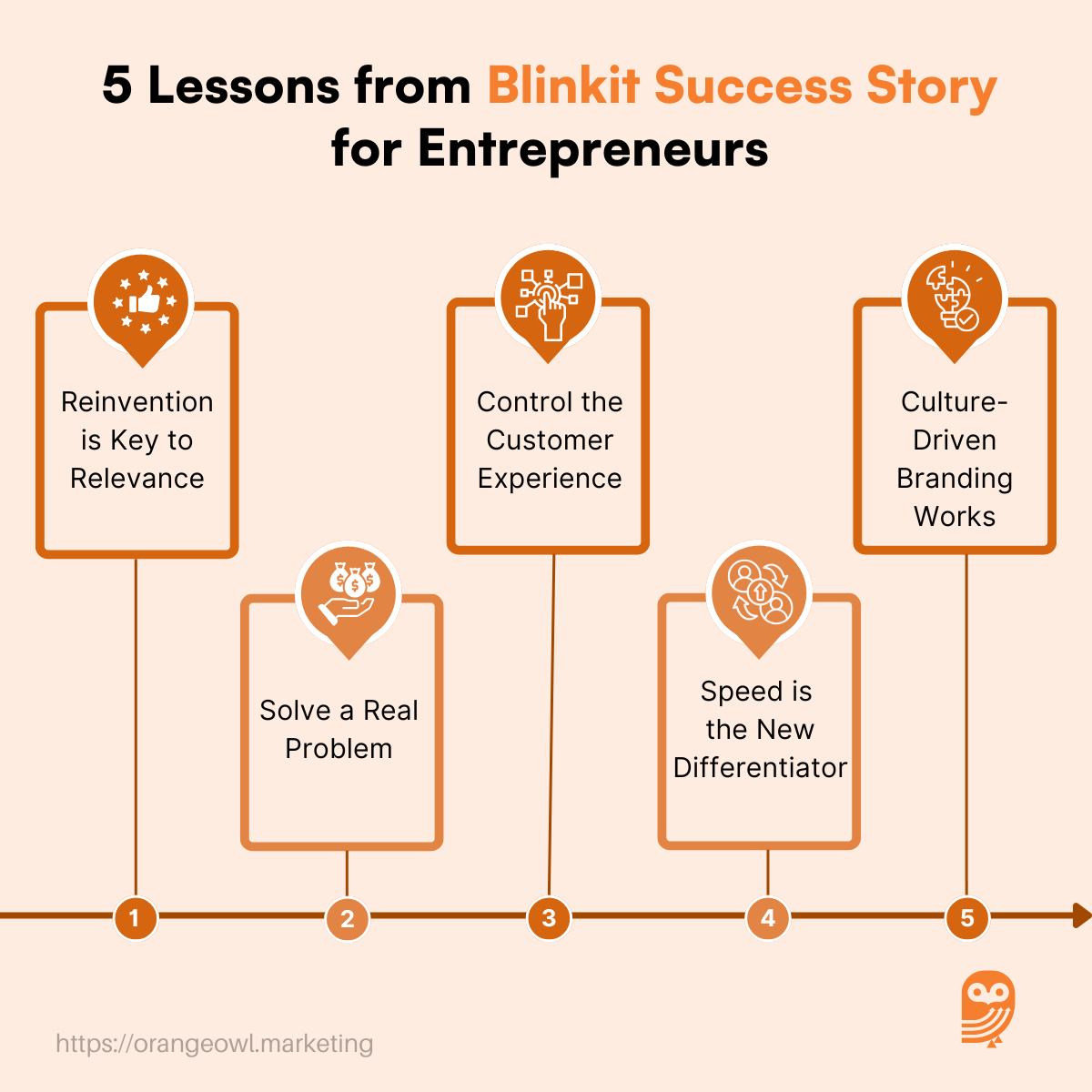Blinkit Success Story: 5 Key Lessons for Every Entrepreneur
Vivek Goel
April 19, 2025

Table of Contents
Introduction
In the fast-paced world of urban retail, Blinkit (formerly Grofers) has emerged as a pioneer in the ultra-fast commerce space in India. Founded in 2013 by Albinder Dhindsa and Saurabh Kumar, Blinkit began as a hyperlocal grocery delivery service and has since evolved into one of India’s leading instant commerce platforms. The company rebranded to Blinkit in 2021, reflecting its bold pivot toward delivering groceries and daily essentials in under 10 minutes. This shift was not just a rebranding exercise but a radical transformation of its business model.
Acquired by Zomato in 2022, Blinkit now operates at the intersection of speed, technology, and convenience. It has redefined the way urban India shops for daily needs, turning quick commerce into a staple for city dwellers. As of 2024, Blinkit fulfills over 400,000 orders per day, underscoring the rising consumer appetite for hyper-efficiency in delivery services. This success story is a compelling case study in adaptability, innovation, and execution.
Origin Story
The journey of Blinkit started when Albinder Dhindsa, an ex-Zomato executive, and Saurabh Kumar, an IIT graduate, identified inefficiencies in India’s traditional grocery shopping system. Despite the rise of e-commerce, grocery retail remained largely offline and inconsistent. Consumers spent significant time visiting multiple stores for essentials, and convenience was a luxury, not a norm.
In 2013, they launched Grofers in Gurgaon, initially as a B2B platform connecting local merchants with customers. However, it soon transitioned into a B2C model, focusing on grocery delivery through a mobile-first interface. Their vision was to simplify grocery shopping for urban consumers, allowing them to order essentials with just a few taps. This early insight into consumer pain points laid the groundwork for a disruptive business.
“We wanted to make buying groceries as easy as ordering food online. The idea was simple—people shouldn’t have to plan grocery shopping days in advance.” — Albinder Dhindsa
Business Space and Early Challenges
Blinkit entered a highly fragmented and competitive grocery market dominated by traditional kirana stores and legacy players. Early operations followed a marketplace model, where orders were fulfilled by local merchants. However, this led to inconsistent service, inventory issues, and customer dissatisfaction.
To overcome these hurdles, Blinkit adopted a dark store model. These are small warehouses strategically located across cities to store high-demand inventory. This gave the company greater control over supply chains, delivery speed, and product quality. The shift allowed Blinkit to offer a more reliable and scalable service, dramatically improving customer experience.
Additionally, the concept of ultra-fast delivery was initially met with skepticism. Many industry experts questioned the feasibility and necessity of 10-minute grocery deliveries. However, Blinkit stayed committed to its vision, continuously optimizing logistics and leveraging data to make quick commerce viable and valuable.
“We weren’t chasing a trend. We genuinely believed that instant delivery could change consumer behavior—and we’ve seen that happen.” — Albinder Dhindsa
Growth Strategies
Blinkit’s growth has been fueled by its willingness to take calculated risks and its deep understanding of evolving consumer behaviors. The rebranding from Grofers to Blinkit signified more than just a name change—it was a signal of a complete operational overhaul. The company decided to double down on the quick commerce model, targeting impulse-driven and last-minute needs.
Key to this growth was the rapid deployment of dark stores in urban neighborhoods, ensuring that every order could be fulfilled within a 2-kilometer radius. Blinkit also limited its SKUs to high-frequency items, making its supply chain lean and responsive. This focus allowed the company to deliver on its 10-minute promise consistently.
The acquisition by Zomato in 2022 further accelerated Blinkit’s expansion. With access to Zomato’s logistics infrastructure, customer base, and financial support, Blinkit was able to expand into new cities and scale operations efficiently. Technology played a critical role, with AI-driven inventory planning, route optimization, and app personalization enhancing operational effectiveness.
“We realized that speed wasn’t just a gimmick. It was a utility. People loved it because it made life easier in ways they didn’t expect.” — Albinder Dhindsa
Marketing Strategies
Blinkit’s marketing approach is a masterclass in contemporary digital branding. From quirky social media posts to culturally relevant memes, the brand has carved out a unique voice that resonates with urban millennials and Gen Z. Their messaging focuses on real-life situations—forgotten groceries, impromptu parties, last-minute cooking needs—to showcase how Blinkit can save the day.
Content marketing and influencer partnerships have played a crucial role in driving brand awareness. By collaborating with relatable personalities and creating humorous, situation-driven content, Blinkit built a strong emotional connection with its audience. The brand’s presence on Twitter and Instagram is particularly noteworthy for its timely, witty responses and viral campaigns.
Moreover, Blinkit invested in in-app gamification and referral programs to enhance user engagement and retention. Discounts, loyalty programs, and personalized offers made it not just a service, but a daily habit for users. Its marketing success lies in seamlessly integrating product utility with culture and emotion.
“Our communication has always been about real moments. Blinkit is not a luxury—it’s a life-saver when you need something right now.” — Albinder Dhindsa
5 Lessons Every Entrepreneur Should Learn from Blinkit
1. Reinvention is Key to Relevance
One of Blinkit’s most remarkable strengths lies in its ability to reinvent itself in response to a rapidly evolving market. What began as Grofers, a standard grocery delivery platform, transitioned into Blinkit — a brand promising ultra-fast 10-minute deliveries. This pivot was not just a change in branding but a complete overhaul of the business model, logistics, and customer promise.
The company recognized the shift in consumer expectations towards instant gratification and boldly realigned its operations to meet that need. Entrepreneurs must learn that in today’s dynamic landscape, clinging to an old model can be limiting. Instead, embracing change and reinventing the wheel can lead to extraordinary growth.
“The ability to pivot is not just about survival, it’s about building something meaningful in changing times.” — Albinder Dhindsa, Co-founder & CEO, Blinkit
2. Solve a Real Problem
At the core of Blinkit’s success is a simple but powerful premise — making daily essentials instantly accessible. The company didn’t set out to merely sell groceries; it aimed to remove the friction of traditional grocery shopping. By solving a real, high-frequency problem — the need for fast, reliable access to daily necessities — Blinkit positioned itself as an essential utility in urban households.
This lesson is crucial: if your business genuinely improves lives and fills a market gap, customers will follow. Blinkit became relevant not because of what it sold, but how it solved a very real problem for time-starved consumers.
3. Control the Customer Experience
Early on, Blinkit shifted from a third-party marketplace model to an inventory-led approach using strategically located dark stores. This allowed the company to control every aspect of the customer experience — from inventory availability and order accuracy to delivery speed and customer service.
In an age where trust and reliability are non-negotiable, owning the entire supply chain gave Blinkit a competitive edge. For entrepreneurs, this is a clear reminder: if your customer experience is dependent on too many external factors, it becomes fragile. Ownership and control often equate to better service and stronger brand equity.
4. Speed is the New Differentiator
Blinkit’s 10-minute delivery promise sparked both admiration and debate, but undeniably, it changed the rules of engagement in the delivery space. While many saw it as a bold — even risky — move, Blinkit recognized that speed itself could be a unique selling proposition.
In an era where consumers are willing to pay for convenience and immediacy, being faster than the competition became a differentiator that consumers remembered and talked about. Entrepreneurs should note that in some industries, reducing friction and wait times can be a bigger advantage than price or product variety.
5. Culture-Driven Branding Works
From clever billboard campaigns to meme marketing and regional lingo in push notifications, Blinkit has built a brand that resonates with India’s millennial and Gen Z audience. Their branding isn’t just functional — it’s fun, relatable, and deeply embedded in pop culture.
This approach helped them break through the noise in a competitive space and build an emotional connection with their audience. The key takeaway for entrepreneurs? Don’t just sell a product — sell a vibe. When your brand feels like a part of the consumer’s lifestyle and culture, it becomes more than a service; it becomes a habit.
Conclusion: Key Takeaways from Blinkit’s Journey
Blinkit’s evolution from Grofers—a conventional online grocery delivery service—to a pioneer in 10-minute deliveries under the new brand identity is nothing short of transformative. What sets Blinkit apart is not just its ability to recognize changing consumer behaviors, but its fearless approach to pivoting at the right time. Reinvention wasn’t just an option—it was essential. This level of agility, combined with a deep commitment to customer satisfaction, allowed Blinkit to emerge as a front-runner in India’s quick commerce revolution.
The brand’s journey also highlights the value of solving real, everyday problems with meaningful innovation. Blinkit didn’t chase trends—it focused on reducing pain points like long delivery windows and inconsistent product availability. By setting up hyperlocal dark stores and owning the last-mile delivery process, it ensured reliability, speed, and control—factors that built long-term customer trust.
Just as important as operations and logistics was Blinkit’s branding and cultural connection. Through witty, hyper-local communication and pop-culture-driven marketing, the brand didn’t just sell groceries—it sold convenience wrapped in familiarity. This emotional resonance has made Blinkit a household name, especially among urban millennials and Gen Z consumers.
For entrepreneurs and startup founders, Blinkit’s story is a powerful case study in adaptability, speed, and customer obsession. It teaches us that success is not just about launching a good product—it’s about constantly re-evaluating, iterating, and scaling what works, even when it means taking bold, unconventional risks. The future belongs to businesses that can think fast, move faster, and remain relentlessly aligned with the needs and expectations of their consumers.
Blinkit is more than just a company—it’s a playbook for 21st-century entrepreneurship.



